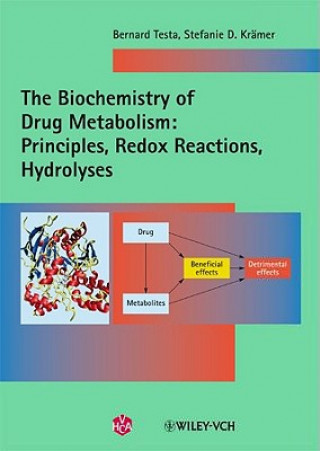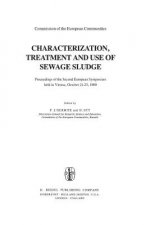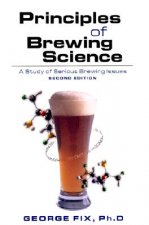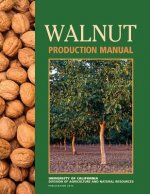
Kod: 05045411
Biochemistry of Drug Metabolism - Two Volume Set
Autor Bernard Testa, Stefanie D. Kramer
Offering a conceptual and factual presentation of the metabolism of drugs and other xenobiotics, these two volumes distinctly focus on the biochemistry, with an emphasis on xenobiotic-metabolizing enzymes, their reactions and regu ... więcej
- Język:
 Angielski
Angielski - Oprawa: Miękka
- Liczba stron: 950
Wydawca: Helvitica Chimica Acta Verlag,Switzerland, 2010
- Więcej informacji o książce

Zobacz książki o podobnej tematyce
-

Alexander and Alestria
69.46 zł -4 % -

Chicago's Nelson Algren
56.31 zł -23 % -

Adventures into Mexico
694.91 zł -

Characterization, Treatment and Use of Sewage Sludge
1118.17 zł -

Children's Literature and Learner Empowerment
291.03 zł -

Decision Theory - An Introduction to Dynamic Programming & Sequential Decisions
633.67 zł -

Clausewitz's Timeless Trinity
899.01 zł
Powiadomienie o dostępności
Wpisz swój adres e-mail, aby otrzymać od nas powiadomienie,
gdy książka będzie dostępna. Proste, prawda?
Więcej informacji o Biochemistry of Drug Metabolism - Two Volume Set
 Opis
Opis
Offering a conceptual and factual presentation of the metabolism of drugs and other xenobiotics, these two volumes distinctly focus on the biochemistry, with an emphasis on xenobiotic-metabolizing enzymes, their reactions and regulations. The first volume is divided into three parts. Part One begins by introducing xenobiotics in the broad context of physiological metabolism, and continues with an overview of the processes of drug disposition and metabolism. It then goes on to summarize the macroscopic and microscopic locations of drug metabolism in animals and humans. This is followed by an introduction to the all-important issue of the consequences of drug and xenobiotic metabolism, providing an initial overview of pharmacokinetic, pharmacological and toxicological consequences. The last chapter examines drug metabolism in the context of drug research, with a focus on medicinal chemistry. The second part is a major component of the book, corresponding to the role of oxidoreductases as major agents of metabolism. Cytochromes P450 receive particular attention, namely their multiplicity, structure, catalytic mechanisms, and the various reactions they catalyze, while other oxidoreductases are also presented, such as flavin monooxygenases, monoamine oxidases and other amine oxidases, aldehyde oxidase and xanthine dehydrogenase, peroxidases, and dehydrogenases-reductases. Each drug-metabolizing enzyme or enzyme family begins with an Enzyme Identity Card summarizing its nomenclature and biochemical essentials. Part Three begins with a survey of the classification, properties and catalytic mechanism of the innumerable hydrolases known or suspected to play a role in xenobiotic metabolism. The focus then shifts to a systematic presentation of the various substrates classes, namely carboxylic esters, amides and peptides, lactams and lactones, esters of inorganic acids, alkene and arene epoxides, and some miscellaneous hydrolyzable moieties. Volume Two contains the last four parts of this work. Part 4 is devoted to the huge field of conjugation reactions, with much information being given on transferases. As in the two preceding parts, each drug-metabolizing enzyme or enzyme family begins with an Enzyme Identity Card summarizing its nomenclature and biochemical essentials. The reactions examined here include methylation, sulfation, glucuronidation, acetylation, conjugation with glutathione, while there is also a rigorous presentation of the pivotal role of xenobiotic-coenzyme A conjugates as a crossroads to various metabolic reactions. The next part examines the consequences of drug and xenobiotic metabolism in a pharmacological and toxicological perspective, with due attention paid to full activation, as is found with prodrugs, and to the worrying case of xenobiotic toxification. Parts 6 and 7 cover the inter-individual and intra-individual factors that influence drug metabolism, starting with an introduction to evolutionary events leading to species differences in the metabolism of xenobiotics and to polymorphisms within a particular species. Focusing on humans, the most relevant polymorphic drug-metabolizing enzymes are discussed, concentrating on ethnic differences and on the consequences for the pharmacokinetic behavior of affected drugs, while also introducing sex-dependent metabolic reactions. The final part introduces the mechanisms leading to increases or decreases in enzyme activities as the concept of enzyme induction via nuclear receptors and the different mechanisms of enzyme inhibition are explained. With these basics in mind, various influencing factors are discussed, including physiological and pathological conditions, as well as drugs, nutrients and environmental agents with a special focus on drug-drug interactions. With a foreword by Prof Leslie Z. Benet, the renowned biopharmaceutical scientist.
 Szczegóły książki
Szczegóły książki
Kategoria Książki po angielsku Technology, engineering, agriculture Industrial chemistry & manufacturing technologies Industrial chemistry
- Pełny tytuł: Biochemistry of Drug Metabolism - Two Volume Set
- Autor: Bernard Testa, Stefanie D. Kramer
- Język:
 Angielski
Angielski - Oprawa: Miękka
- Liczba stron: 950
- EAN: 9783906390550
- ISBN: 3906390551
- ID: 05045411
- Wydawca: Helvitica Chimica Acta Verlag,Switzerland
- Waga: 2324 g
- Wymiary: 248 × 168 × 49 mm
- Data wydania: 14. April 2010
Ulubione w innej kategorii
-

Understanding Wine Technology
136.33 zł -23 % -

Art of Beef Cutting - A Meat Professional's Guide to Butchering and Merchandising
197.46 zł -5 % -

French Patisserie
207.20 zł -23 % -

Art of Making Fermented Sausages
85.22 zł -4 % -

Malt
70.16 zł -23 % -

Mouthfeel
293.44 zł -

Salami
552.96 zł -

Principles of Brewing Science
131.51 zł -7 % -

Pharmaceutical Competitive Intelligence for the Regulatory Affairs Professional
348.96 zł -

Organic Chemistry of Drug Design and Drug Action
439.21 zł -6 % -

Craft Maltsters' Handbook
144.05 zł -

Designing Plastic Parts for Assembly
668.61 zł -

Introduction to Chemical Engineering - Tools for day and Tomorrow, 5th Edition
389.42 zł -

How To Brew
105.20 zł -4 % -

Designing Great Beers
88.44 zł -23 % -

Soapmaker's Companion
93.26 zł -5 % -

Introduction to Perfumery
418.83 zł -

Future Foods
106.41 zł -33 % -

Camra's Home-Brewing Problem Solver
65.55 zł -17 % -

Chromatopia
88.14 zł -23 % -

Craft and Science of Coffee
526.95 zł -9 % -

Food Processing Technology
607.67 zł -

Food Safety - The Science of Keeping Food Safe 2e
394.64 zł -

Altbier
73.08 zł -6 % -

Undiscovered Self
108.31 zł -

Note-by-Note Cooking
120.96 zł -4 % -

Formulation and Preparation of Cosmetics, Fragrances and Flavors
353.27 zł -

New Brewing Lager Beer
92.35 zł -7 % -

Microbiome, Immunity, Digestive Health and Nutrition
826.03 zł -

Wine Chemistry and Biochemistry
1542.34 zł -

Coulson and Richardson's Chemical Engineering
554.86 zł -

Food Microbiology
976.92 zł -

Voigt's Pharmaceutical Technology
669.92 zł -

Manufacturing: Process Techniques for the Cosmetic Industry
1028.72 zł -

Oktoberfest, Vienna, Marzen
61.23 zł -7 % -

Cosmetic Creams - Development, Manufacture and Marketing of Effective Skin Care Products
706.06 zł -

Belgian Ale
42.56 zł -23 % -

Pigment Processing
931.41 zł -

Continental Pilsener
61.23 zł -7 % -

Amber Revolution
161.12 zł -

Natural Soap Book
65.35 zł -4 % -

Cosmeceuticals and Cosmetic Ingredients
1026.51 zł -

Injection Mold Design Engineering
642.41 zł -

Colour
37.94 zł -23 % -

Brewing
168.65 zł -

Walnut Production Manual
320.45 zł -

Emperor Of Scent
51.69 zł -23 % -

Chemical Formulary, Volume 1
223.97 zł -45 % -

Pigment Compendium
1103.31 zł
zadowolonych klientów
Od roku 2008 obsłużyliśmy wielu miłośników książek, ale dla nas każdy był tym wyjątkowym.
Copyright! ©2008-24 libristo.pl Wszelkie prawa zastrzeżonePrywatnieCookies



 21 milionów książek
21 milionów książek Dostawa 10.99 zł
Dostawa 10.99 zł (32) 444 93 66 (8-15.30h)
(32) 444 93 66 (8-15.30h)